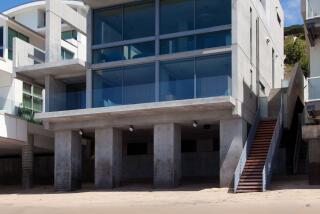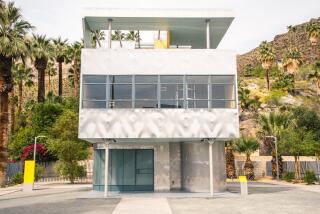Childhood home, now on the market, leads to life as an architect
Jay Farbstein saw his first design sketch at age 11 — drawn before his eyes by architect Calvin Straub, who had been hired by Farbstein’s parents to envision their new Pacific Palisades home.
Farbstein was so struck that an imagined building could be realized on both paper and land that it primed him for a career as an architect.
“I probably don’t remember anything else when I was 11,” said Farbstein, who now heads Pacific Palisades-based Farbstein & Associates.
That Straub-designed post-and-beam residence, which cost $50,000 in 1956, is now listed for $7.249 million, making it “probably one of the best investments my parents ever made,” Farbstein said.
Siblings Jay and Ellie Farbstein are selling the four-bedroom, three-bathroom midcentury home following the death of their parents, Milton and Olga Farbstein, residents since the home was built.
“We’ve been cleaning out 50 years of memories,” said Ellie Farbstein, a Santa Monica-based artist. “I got a lot of my artistic sensibility from living in such a beautiful place.”
The 3,345-square-foot home could easily be mistaken for a Zen woodland retreat. Window-walls, some resembling Japanese screens, augment the home’s horizontal stretch beneath pitched fir ceilings trimmed with clerestory windows.
Straub designed the home’s four wings to embrace existing oak and sycamore trees on the 2-acre property. There isn’t a window view does not overlook a kind of “private splendor,” according to a 1959 cover story in the Los Angeles Examiner’s Pictorial Living section: “When Nature Sets the Stage.”
Original ash wood cabinetry is built into most rooms. The only change through the decades: parquet wood flooring that replaced cork, and Formica that was swapped out for granite kitchen countertops.
The den, living room and master bedroom harbor brick fireplaces, and skylights wash the kitchen and two bathrooms with additional light. Roof overhangs and cantilevers, some with square cutouts, help cool the house in summer.
The Farbsteins’ well-traveled parents had a discerning aesthetic — the family had previously lived in a Cheviot Hills architect-designed home.
“Our house was always the center of activity and entertainment,” said Ellie Farbstein, who was 8 when the family moved into the home; her brother was 12. The home’s indoor-outdoor ease was optimal for children dashing out to the pool or into the woods to play by a creek that still edges the property.
Farbstein said his boyhood memories will remain fresh — his current home, the third he has designed for himself, is next door to his childhood one. “I’m looking out my office window at it as we talk,” he said.
“This house borrows from the idea of fitting the house around the trees,” said Farbstein, who lives with his wife, Bonnie, in the 2009 five-bedroom, four-bathroom “quietly contemporary” modernist home.
After earning a master’s degree in architecture from the Harvard Graduate School of Design, Farbstein worked in Milan and at London’s Bartlett School of Architecture, where he earned a Ph.D. in the field. He now does facility planning for courthouses, jails and other justice projects.
Called the father of California post-and-beam architecture, Straub embraced a humanist approach: His clients’ rapport with a home’s aesthetic was far more important than the aesthetic itself.
As a USC professor of architecture, Straub joined with two of his students, Conrad Buff and Donald Hensman, to form Buff, Straub & Hensman, from 1958 to 1963. The Sierra Madre firm is now named Buff, Smith & Hensman; Straub died in 1998.
Susân Perryman of Hilton & Hyland holds the listing.
More to Read
Sign up for Essential California
The most important California stories and recommendations in your inbox every morning.
You may occasionally receive promotional content from the Los Angeles Times.






